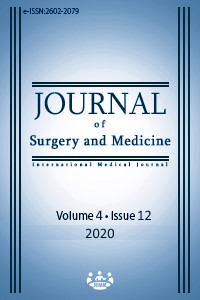Can ischemia modified albumin (IMA) and total sulfhydryl level (TSH) be used as a biomarker in the diagnosis of bladder tumor? A prospective case-control study
Keywords:
IMA, BLADDER TUMOR, Total TSHAbstract
Aim: Bladder tumor is one of the most common cancers. Cystoscopy, which is an invasive procedure, is used in its diagnosis. We conducted a study to determine whether a more non-invasive method can be used for this purpose. In this study, the uses of Ischemia Modified Albumin (IMA) and total sulfhydryl level (TSH), which are both antioxidant markers, were investigated for the diagnosis of bladder tumor. Methods: Ischemia Modified Albumin (IMA) and total sulfhydryl level (TSH) were identified by the spectrophotometric method. Patients with primary bladder tumors who did not receive any prior treatments or undergo any interventions were included in this prospective case control study. Those with severe cardiac and neurological diseases, other malignancies, acute and chronic infectious diseases, active organ failure, chronic obstructive pulmonary diseases, and other ischemic immunosuppressive diseases, along with individuals with severely low or high serum albumin levels (<20 or >55 g/L) were excluded from the study. Results: Forty-two primary bladder tumors and 45 healthy volunteers were included in the study. Serum IMA and TSH levels of the patient and control groups were compared. Patients with bladder tumors had high serum IMA (P=0.045) levels and low TSH levels (P=0.033). Conclusion: Both IMA and total TSH can be considered non-invasive biomarkers in the diagnosis of bladder tumor. Since there are few studies on this subject in the literature, further, larger studies are needed.
Downloads
References
Antoni S, Ferlay J, Soerjomataram I, Znaor A, Jemal A, Bray F. Bladder cancer incidence and mortality: a global overview and recent trends. European Urology. 2017;71(1):96–108.
Sawicka E, Kratz EM, Szymańska B, Guzik A, Wesołowski A, Kowal P, et al. Preliminary Study on Selected Markers of Oxidative Stress, Inflammation and Angiogenesis in Patients with Bladder Cancer. Pathol Oncol Res. 2019 Mar 4. doi: 10.1007/s12253-019-00620-5.
Awadallah SM, Atoum MF, Nimer NA. Ischemia modified albumin: an oxidative stress marker in beta-thalassemia major. Clin Chim Acta 2012; 413(9-10):907-10.
Uzar E, Tamam Y, Evliyaoglu O, Tuzcu A, Beyaz C, Acar A, et al. Serum prolidase activity and oxidative status in patients with diabetic neuropathy. Neurol Sci. 2012;33(4):875-80.
Chawla R, Goyal N, Calton R, Goyal S. Ischemia modified albumin: A novel marker for acute coronary syndrome. Indian J Clin Biochem. 2006;21:77-82.
Lee E, Eom JE, Jeon KH, Kim TH, Kim E, Jhon GJ, et al. Evaluation of albumin structural modifications through cobalt-albumin binding (CAB) assay. J Pharm Biomed Anal. 2014;91:17-23.
Sbarouni E, Georgiadou P, Voudris V. Ischemia modified albumin changes review and clinical implications. Clin Chem Lab Med 2011;49:177-84.
Zurawska-Płaksej E, Grzebyk E, Marciniak D, Szymańska-Chabowska A, Piwowar A. Oxidatively modified forms of albumin in patients with risk factors of metabolic syndrome. J Endocrinol Invest. 2014;37:819-27.
Sbarouni E, Georgiadou P, Voudris V. Ischemia modified albumin changes - review and clinical implications. Clin Chem Lab Med. 2011; 49(2):177-84.
Cakir M, Karahan SC, Mentese A, Sag E, Cobanoglu U, Polat TB, et al. Ischemia modified albumin levels in children with chronic liver disease. Gut Liver 2012;6(1):92-7.
Hu ML. Measurement of protein thiol groups and glutathione in plasma. Meîhod Enzymol. 233:380(S994).
Stockcr R, Frei B. Endogenous antioxidant defences İn human blood plasma,"Oxidative Stress: Oxidants and Antioxidants, editör: Sies H, Acedemic Press, London (1991):213.
Valko M, Rhodes CJ, Moncol J, Izakovic M, Mazur M. Free radicals, metals and antioxidants in oxidative stress-induced cancer. Chem Biol Interact. 2006;160:1–40.
Islam MO, Bacchetti T, Ferretti G. Alterations of Antioxidant Enzymes and Biomarkers of Nitro-oxidative Stress in Tissues of Bladder Cancer. Oxid Med Cell Longev. 2019 May 5;2019:2730896. doi: 10.1155/2019/2730896. eCollection 2019
Huang QX, Ma J, Wang YS. Significance of preoperative ischemia-modified albumin in operable and advanced gastric cancer. Cancer Biomark. 2018;22(3):477-85.
Erkut N, Mentese A, Ozbas HM, Sumer A, Orem A, Topbas M, et al. The indicator of hypoxia in acute leukemia: Ischemia-modified albumin. Cancer Biomark. 2015;15(5):559-65.
Da Silveira RA, Hermes CL, Almeida TC, Bochi GV, De Bona KS, Moretto MB. et al. Ischemia-modified albumin and inflammatory biomarkers in patients with prostate cancer Clin Lab. 2014;60(10):1703-8.
Ellidag HY, Eren E, Aydin O, Akgol E, Yalcinkaya S, Sezer C, et al. Ischemia modified albumin levels and oxidative stress in patients with bladder cancer Asian Pac J Cancer Prev. 2013;14(5):2759-63.
Wong R, Rosser CJ. UroSEEK gene panel for bladder cancer surveillance Transl Androl Urol. 2019 Dec;8(Suppl 5):S546-9.
Ryrfeldt A, Bannenberg G, Moldeus P. Free radicals and lung disease. British Med Bull. 1993;49(3):588-603.
Cotgreave IA, Johansson U, Moldeus P, Brattsand R. The effect of acute cigarette smoke inhalation on pulmonary and systemic cysteine and glutathione redox states in the rat. Toxicology. 1987;45:203-12.
Downloads
- 408 742
Published
Issue
Section
How to Cite
License
Copyright (c) 2020 Recep Eryılmaz, Canan Demir, Rahmi Aslan, Halit Demir, Kerem Taken
This work is licensed under a Creative Commons Attribution-NonCommercial-NoDerivatives 4.0 International License.
















